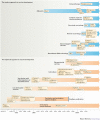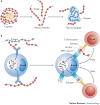From empiricism to rational design: a personal perspective of the evolution of vaccine development
- PMID: 24925139
- PMCID: PMC7096907
- DOI: 10.1038/nri3694
From empiricism to rational design: a personal perspective of the evolution of vaccine development
Abstract
Vaccination, which is the most effective medical intervention that has ever been introduced, originated from the observation that individuals who survived a plague or smallpox would not get the disease twice. To mimic the protective effects of natural infection, Jenner - and later Pasteur - inoculated individuals with attenuated or killed disease-causing agents. This empirical approach inspired a century of vaccine development and the effective prophylaxis of many infectious diseases. From the 1980s, several waves of new technologies have enabled the development of novel vaccines that would not have been possible using the empirical approach. The technological revolution in the field of vaccination is now continuing, and it is delivering novel and safer vaccines. In this Timeline article, we provide our views on the transition from empiricism to rational vaccine design.
Conflict of interest statement
Ennio De Gregorio and Rino Rappuoli are full-time employees and shareholders of Novartis Vaccines. The following products are commercialized by Novartis or are in the pipeline of Novartis Vaccines: MF59 adjuvant; TLR7-based adjuvants; vaccines against
Figures





References
-
- World Health Organization. Global Vaccine Action Plan 2011-2020. (WHO, 2013).
-
- Thucydides. The History of the Peloponnesian War (University of Chicago Press, 1989).
-
- Needham J. China and the origins of immunology. East Horiz. 1980;19:6–12. - PubMed
-
- Leung AK. Vaccinia, Vaccination, Vaccinoiogy: Jenner, Pasteur and Their Successors. 1996. pp. 65–71.
Publication types
MeSH terms
Substances
LinkOut - more resources
Full Text Sources
Other Literature Sources
Medical

